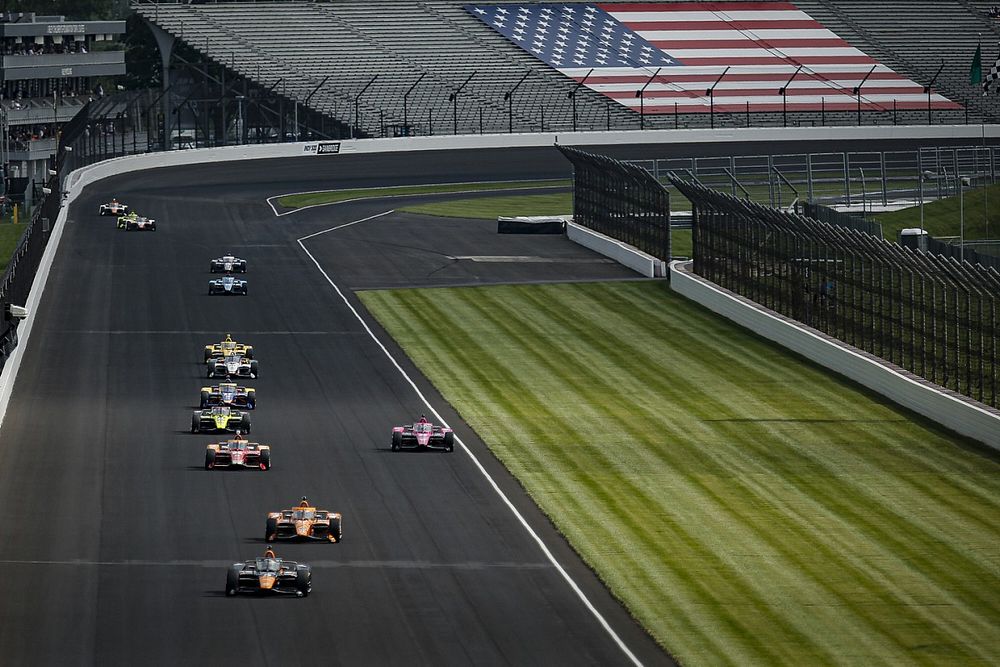IndyCar to test new engine's revised weight distribution at Indy
IndyCar president Jay Frye has confirmed that next month’s test at Indianapolis Motor Speedway will include two cars simulating the weight distribution of the 2.4-liter hybrid engines to be used from 2023.

Barry Cantrell / Motorsport Images
The test, set for Oct. 8, is expected to feature both Jimmie Johnson of Chip Ganassi Racing and Andretti Autosport-bound Romain Grosjean – among others – running the Indy 500-specific Rookie Orientation Program [ROP].
However, there will also be cars present that are running at the same weight – and with the same weight distribution – as the 2023 cars, which will see engine IndyCar’s current engine capacity increased from 2.2-liters to 2.4-liters and with hybrid units attached.
Frye says the additional weight from the engine displacement increase is around 11lbs, due mainly to the larger bottom end, while the hybrid unit – according to various engineers’ estimates – will be between 110 and 140lbs.
“It’s a Firestone tire test,” Frye told Motorsport.com, “so there’s things that they want to sort through, things that we want to sort through in terms of weight difference with the 2.4 engine.
“But it’s also a chance to try new aero parts, as we did at the end of last year in a test at Indy when we were also putting Scott McLaughlin through his ROP. And this time, too, there’s a possibility we can get some ROPs done in preparation for the 2022 season.
“Participation is yet to be determined, as is everything involved, but yes, it will be Oct. 8 at IMS, and it will be mainly about working on things for 2023.”
In terms of the 2.4-liter hybrid simulation part of the test, it will be similar to the mid-2019 test at Texas Motor Speedway carried out by Firestone with Josef Newgarden (Team Penske-Chevrolet) and Graham Rahal (Rahal Letterman Lanigan-Honda). Despite the lack of finalized aeroscreens available at the time, the two cars had their weight shifted forward and upward in order to simulate the revised weight distribution caused by the safety device, and its effect on various tire constructions and compounds.
“Again, that tire test side of it will involve two cars – one from each manufacturer. We will do a worst-case scenario [regarding the weight gain] but we’re also diligently working to reduce the effect of the weight before 2023. There’s still some work to do but we’ve made good progress.”
Frye also stuck by his projection that the two manufacturers would be able to commence their on-track testing of the 2.4-liter hybrids in the first quarter of next year – “things are going really well there” – but said it has not yet been decided which teams or drivers would be involved.
“There’s multiple ways we can do it,” he said, “and it may be like the first segment of aerokit testing: two teams, two drivers. The main reason for doing it like that is because of the limited amount of parts and pieces at first, so we need to use them wisely and get as much out of them as you can. Then phase 2 would expand to involve more teams, more drivers.
“We haven’t got that finalized yet, but it will be soon. Having Oriol [Servia] and Juan [Pablo Montoya] worked fine for the aerokit testing for 2018 – they were current drivers but not fulltime. It’s not necessarily going to be done quite the same way this time. We’ll know soon.”
Cara Adams, director of race tire engineering and manufacturing at Bridgestone Americas, confirmed the tire test aspect of the day at IMS would be focused on assessing what needed to be done to the compounds for 2023.
“We don’t plan on making any changes for Indianapolis tires next year,” she told Motorsport.com. “Our focus will be on development of the tires for the 2023 hybrid-era vehicles. We hope to run at the power levels we expect to see from the 2023 cars – not the extra hybrid power level, but the base power level of the 2.4-liter cars. And then there may be a follow-up test early next year, too, to dive a little deeper into what we learn from the October test.”
Adams said that she feels Firestone got on top of the demands made on the tires by the addition of the aeroscreen in 2020.
“Certainly we’ve done a lot of work to understand what was required,” she said, “and we’re aware that is going to change again for 2023. There’s going to be more weight, although it will move rearward about one percent and there will be additional downforce at the ovals to help with that additional weight.
“The simulated new weight and power balance in the October test will certainly help with the direction that we take. However, until you have the actual parts physically on the car and understand the system as a whole, it’s only going to give you direction – it’s not going to fully replicate the performance you see on the vehicle.”
Be part of Motorsport community
Join the conversationShare Or Save This Story
Subscribe and access Motorsport.com with your ad-blocker.
From Formula 1 to MotoGP we report straight from the paddock because we love our sport, just like you. In order to keep delivering our expert journalism, our website uses advertising. Still, we want to give you the opportunity to enjoy an ad-free and tracker-free website and to continue using your adblocker.















Top Comments